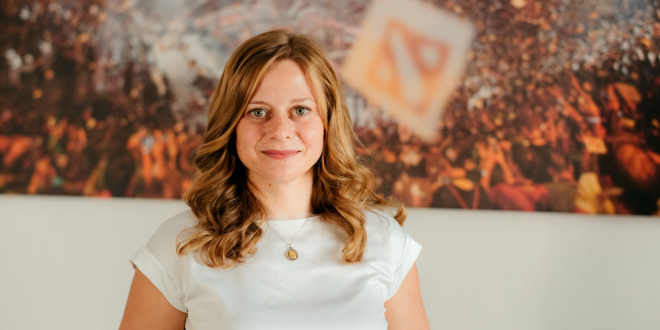Darina Goldin, Director of Data Science at Bayes Esports, takes a deep dive into the side advantage in CS:GO as she questions whether it is dictated by the game, or if there are other factors at play.
At Bayes Esports, we enjoy analysing esports data to gain new insights into the games and improve our predictive models. We believe in growing the ecosystem and sharing our findings with the world.
Previously, we have written about such topics as match momentum in Counter-Strike, opening strategies, or comebacks. This time we take a deeper look at the side advantage in CS:GO – is it really dictated by the game or could there be something more at play here?
The side advantage
It is a well known fact that CS:GO is not a perfectly balanced game. In theory, it should always be much easier to play the game as Counter-Terrorists than as Terrorists: Sure, you have two points on the map to defend, but all you need to do is lie in wait and snipe the incoming opponents. The terrorists, on the other hand, have to reach one of the two bomb areas and then actually place the bomb. The pressure is on them to make the right first move.
Since this would make the game somewhat predictable and boring, significant efforts are being made by Valve to even out the sides. Terrorists get cheaper weapons, and sometimes the map geometry is stacked in their favour, too. And so, ultimately, we have a colourful selection of maps – some favouring terrorists, some favouring counter-terrorists and some almost perfectly balanced. To measure this balance we look at the average round win rate of terrorists in the first half of each map (where a full 15 rounds are guaranteed to be played). We have plotted the results in the graph below in turquoise. 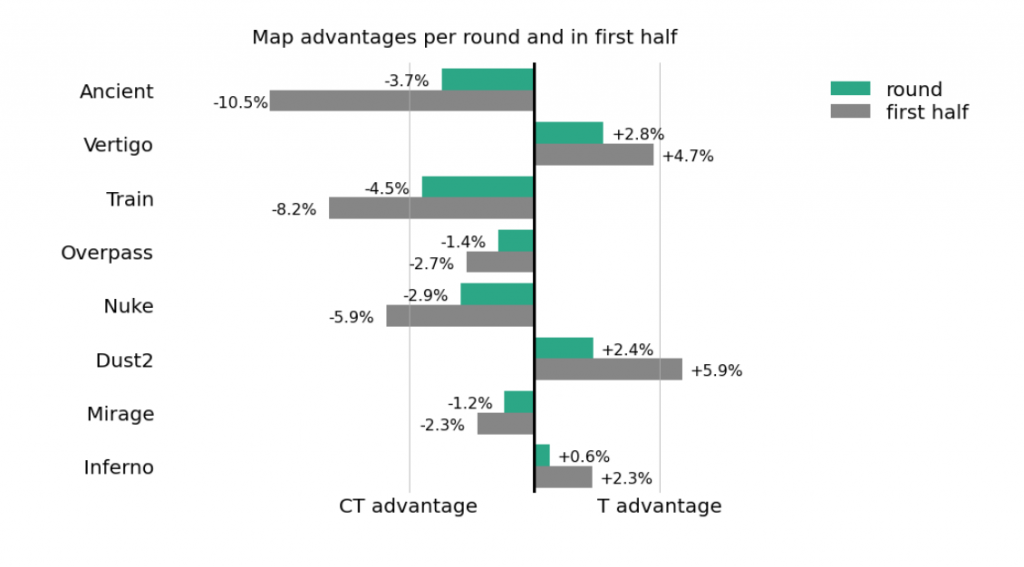
Here we use over ten thousand matches that have been played professionally since the last major economy update in May 2019. The maps are sorted based on their popularity – given by the number of available matches. Train is the map with the largest terrorist disadvantage. Ancient (which replaced it in May 2021), has not really seen enough professional matches to be statistically significant, but seems to be similar to its predecessor. Vertigo and Dust2, on the other hand, firmly favour the terrorist side.
The grey colour in the plot shows how this round win advantage accumulates in the first half. It is intuitively quite clear that if I have a higher win probability in each round I have a higher win probability to win the half, too. We can see this effect quite clearly in the graph above. We have collected some statistics about our data set in the table below. It will be interesting to see how Ancient develops over time and if the current CT advantage goes down as more teams play the map.
So does this mean that starting as terrorists on, say, Train, puts you at an immediate disadvantage? It seems like a foregone conclusion. After all, the more rounds you win in the first half, the fewer you need to win in the second, right? To our great surprise, that is not true at all. Not only that, but we find that, except for Ancient, for all the maps in our data set the team that starts as terrorists won the match more often. For Inferno and Train the outcomes seems nearly evenly distributed, but for Nuke and Overpass the difference is very significant and cannot be explained away purely with team skill. It’s especially interesting because both maps feature a terrorist disadvantage in the first half!
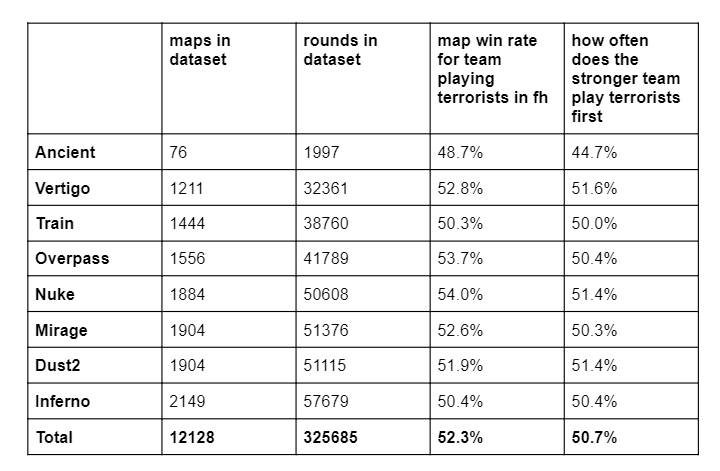 How can this be? Clearly there are more complex dynamics at play here than simply which side has an advantage. We can show that it’s not just the difference in team skill either, though of course there is some connection there. There is nothing in the game itself that can explain why the team that starts as terrorists statistically wins more often on all maps. But there is something if you zoom out far enough: The selection advantage.
How can this be? Clearly there are more complex dynamics at play here than simply which side has an advantage. We can show that it’s not just the difference in team skill either, though of course there is some connection there. There is nothing in the game itself that can explain why the team that starts as terrorists statistically wins more often on all maps. But there is something if you zoom out far enough: The selection advantage.
Choose your map wisely
Maps in Counter-Strike matches are selected from an active duty pool by repeatedly banning and picking maps. How exactly this procedure works depends largely on the tournament, but it is generally known which team picked which map after the event. If we take only maps that were explicitly picked by a team (so the first and second map in a best of three or the first four in a best of five), we see something truly interesting: Controlling for skill differences, the team who chose the map is always more likely to win it. It doesn’t matter which side they start playing on!
Teams, of course, don’t choose maps randomly. They will pick the maps that they are very confident playing on, or maps where they know their opponent has a weakness. Either way, they expect to have an edge on their chosen map. Teams who play rare maps like Vertigo or Overpass, usually have better tactics for these maps, too.
Ancient is a curiosity in this lineup. When this analysis was first concluded, only about 50 maps had been played and the overall win rate for the team who started as terrorists was 54.2%. Fast forward a month, and the numbers have gone down a fair bit from that! It’s interesting to follow the development of such a new map and to see how teams develop and adapt tactics. It will be worth looking back in a year to see how the win rates have changed with more teams being forced to play on Ancient.
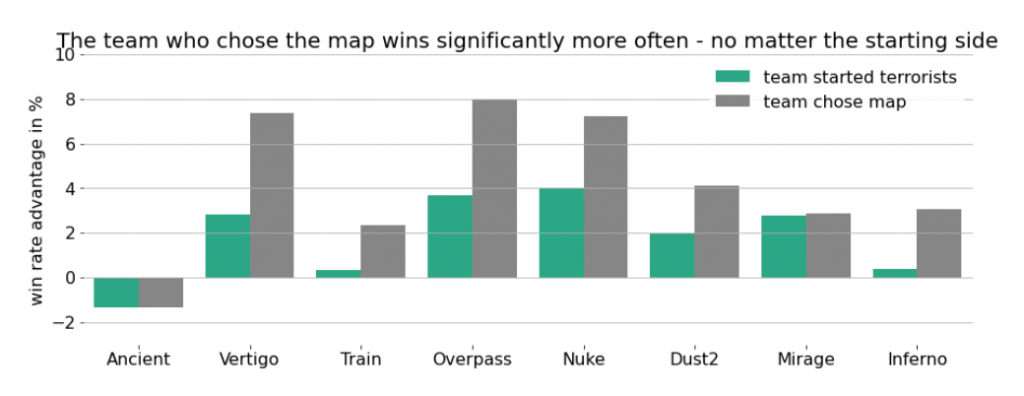 Unfortunately it is not usually known how the starting sides were picked in a match. Sometimes it’s decided by the team who did not choose the map, sometimes by the side who did and sometimes it’s determined by a coin toss or a knife round. We can postulate that each team has a preferred starting side – but it can be either one. Some teams like to start on the easier side to get a morale boost in the first half, while others would rather play the easier side in the second half.
Unfortunately it is not usually known how the starting sides were picked in a match. Sometimes it’s decided by the team who did not choose the map, sometimes by the side who did and sometimes it’s determined by a coin toss or a knife round. We can postulate that each team has a preferred starting side – but it can be either one. Some teams like to start on the easier side to get a morale boost in the first half, while others would rather play the easier side in the second half.
One thing our data shows is that there is a very clear tendency for the team who chose the map to start as terrorists. Even on T-favouring Dust2 the map pickers start as terrorists 63% of the time. On Nuke and Train we are at over 80%. Ancient, in its limited lifetime, has seen only two matches where the team who chose it started out as CT: both times the picking team won the map. No matter the side selection dynamics, it almost looks like the picking team gets pushed into playing terrorists first. And it explains our little paradox.
We know now that the team who picked a map is statistically more likely to win it and we also found that they are a lot more likely to be playing as terrorists first. The side advantages are a real thing, and the teams will still lose the first half on the terrorist-favouring maps. But they will be prepared for this. Remember, both teams get to play both sides. So perhaps you lost the first half 6:9 – but now you go into the second half with the knowledge that you are playing the easier side and have the better tactics. Suddenly a three round disadvantage is not that meaningful anymore.
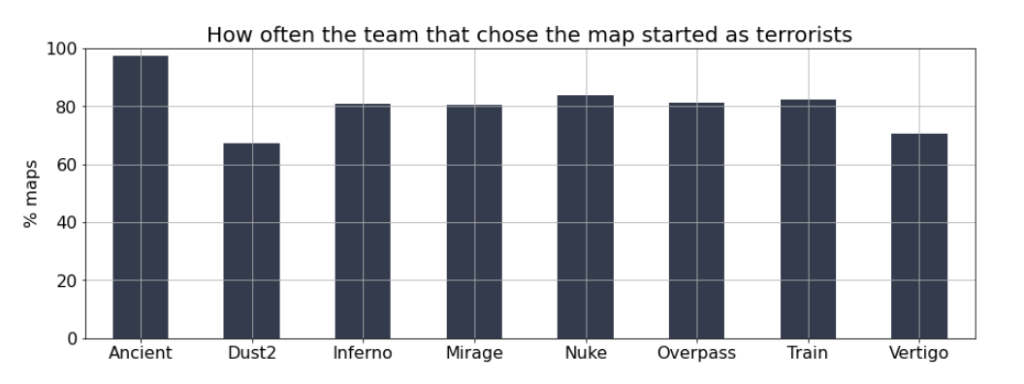 Of course we are still discussing only slight advantages here. If Team Bayes Esports were to face G2 CS:GO, it would not matter which side our company starts on – we’d be lucky if we got one kill throughout the entire map! But if the two teams are of equal skill, it is this slight advantage that might decide the fate of the match. Whether a team won on “their” map or their opponent’s is definitely something we should keep in mind when talking about fairness and match results. And if we are unsure who to bet on, picking the team who chose the map seems to be the safer choice – especially if they start as terrorists!
Of course we are still discussing only slight advantages here. If Team Bayes Esports were to face G2 CS:GO, it would not matter which side our company starts on – we’d be lucky if we got one kill throughout the entire map! But if the two teams are of equal skill, it is this slight advantage that might decide the fate of the match. Whether a team won on “their” map or their opponent’s is definitely something we should keep in mind when talking about fairness and match results. And if we are unsure who to bet on, picking the team who chose the map seems to be the safer choice – especially if they start as terrorists!
